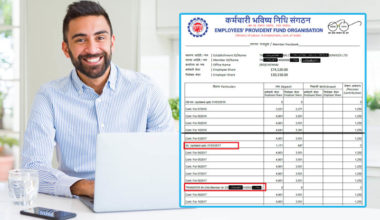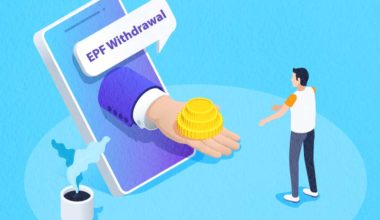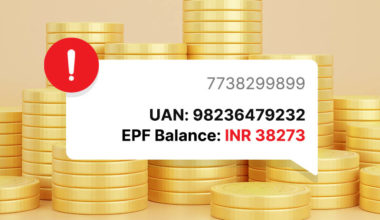The Employee’s Provident Fund scheme was launched by the Ministry of Labor & Employment in 1952. The ministry has been actively managing and implementing this fund since the time for the promotion of savings among the working professionals in the country. The idea behind implementing this scheme was to provide the employees with social security and a secure future as a reward for their hard work and dedication to the organizations. EPF was implemented under the Employees’ Provident Funds Act as a compulsory contributory fund for all working professionals.
Understanding the EPF Scheme in Detail
Explained below are a few important points that you must know about Employees’ Provident Fund–
- As the law states, any business that has equal to or more than 20 employees is bound to enroll under the Employees’ Fund Provident Organization
- There is only one individual EPF account for every employee
- Both the employer and the employee contribute 12% each of the employees’ dearness allowance and basic salary to the EPF on a monthly basis
- Employees can withdraw a part of their EPF after a year of working, in case of emergency
- The employers of NGOs contribute 10% of the employee’s dearness allowance and basic salary towards EPF
- The funds accumulated in the employee’s EPF are accumulated with an interest of 8.5%
- EPF withdrawals made before 5 years of of employment are subject to a tax deduction of 10% of the employee’s EPF balance
What are the Benefits of EPF Scheme?
Following are some of the reasons why it is for your good to invest in Employees’ Provident Fund- a compulsory contributory fund for all working professionals-
- The use of EPFO allows easy redressal to compliance and grievance for employees
- Since the Employees’ Provident Fund is governed by a statutory body, it is mandatory for all organizations to follow all rules and regulations set up by EPFO on a daily basis
- EPFO makes the availability of online services available easily
- With the help of EPF, the claim settlement time has been reduced from 20 days to 3 days
- EPF facilitates the promotion and encouragement of all sorts of voluntary compliance
- For employees, EPF allows them to save a lot of money in the long run
- Monthly contribution to EPF makes it easier for working professionals to save a good amount of money for their requirement, as they do not have to take out a lump sum amount for investment
- Employees can also withdraw a part of their EPF at the time of emergencies
- EPF works as a reliable source of long term investment for employees, whilst building a retirement corpus for them
- The part of an employee’s salary that is deducted towards EPF is a part of his/her non-tax deductible income
- Employees can transfer their EPF corpus from one employer to another as and when they switch jobs
- EPF is a major tax-saving instrument
What are the Services Offered by the EPF Scheme?
EPFO provides various services to organizations and their employees, helping them understand various aspects of the fund. Listed below are some of the major services provided by the EPFO-
- Online Registration
Employees can easily complete the Online Registration of their Establishments (OLRE) online on the EPFO portal
- Generation of UAN Details
Employees can generate their UAN details using the EPFO online portal and then log in to the UMANG application for easy access to all PF-related information
- Online EPF Subscription
Organizations can easily make the PF payments/subscriptions online
- Redressal of Grievances
EPF members can raise a complaint in case of queries regarding the settlement of pension, PF withdrawal, transfer of PF, etc.
- Online Claims Transfer Status and Passbook
EPF members can easily check the status of their PF claims, and/or check/download their PF passbook with the help of a UAN
- Missed Call and SMS Service
Users can easily get the details of their PF account (balance, previous contribution, etc.) simply by sending an SMS (Format: EPFOHO UAN to 7738299899) or by giving a missed call at 011-22901406
- EPF Member Passbook
Members can download their EPF Passbook on the EPFO member portal to take a detailed look at the transactions linked to their contributions and withdrawals from the EPF account.
- Pensioner’s Portal
Employees can get the answers to all their pension-related queries such as Pension Payment Order (PPO), pension credit, passbook details, etc. on the EPFO member portal.
- One Employee, One EPF Account
The EPFO member portal allows EPF account holders to merge their PF accounts, operated/opened by various organizations under their UAN.
- TRRN Query
TRRN stands for Temporary Return Reference Number which is used to check the status of the employee’s PF challan payment.
- Helpdesk
The EPFO member portal provides a helpdesk for all PF related queries of the employees.
- ECR Portal
ECR or Electronic Challan cum Return portal allows employees to register with the e-Sewa portal and generate a user ID and password. The ECR can be uploaded by the employees with digital signatures.
- COC Application Form
COC stands for Certificate of Coverage, which is an application form and can be filled through the website.
What are the various schemes under EPFO?
There are 3 different schemes under the EPFO-
- EPF – Employees Provident Fund Scheme, 1952
- EPS – Employees Pension Scheme, 1995
- EDLI – Employees Deposit Linked Insurance Scheme, 1976
To Conclude:
EPF or Employees’ Provident Fund is a government scheme set up by the EPFO under the guidance of the Ministry of Labor & Employment. The idea behind this scheme was to promote a sense of savings among the employees and to help them build a sufficient retirement corpus for their well being. Both the employers and employees contribute 12% of the employee’s salary to EPF. Similarly, 12% of the employee’s salary is deducted by the employer as a monthly contribution towards EPF. There are innumerable EPFO services and PF benefits offered for the betterment of the retirement of the employees.










